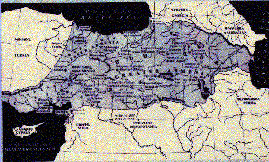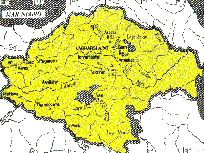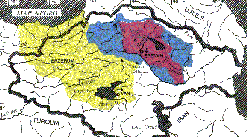
After the Greco-Macedonian conquest (IV B.C.), the Hellenic authors
mentioned Armenia as a people who spoke the Armenian language. Based in
the linguistical identity, in the year 189 B.C., Artashes I declared the
independence from Greek domination, formed the kingdom of Greater Armenia,
and founded the Artaxian dynasty, which ruled until the first century after
Christ. The greatest territorial expansion of Armenia was under the rule
of Tigran the Great, whose authority extended from the Caspian Sea to Palestine
and from Pontus to Mesopotamia.

Rome was neutral at first to the Armenian expansion, but later saw in Tigran an oposition to its own expansion interests and a danger to its new conquests in Asia Minor. In the year 66 A.D. Tigran was captured by the Roman general Pompey after a battlefield defeat.
Trdat was crowned as king of Armenia in Rome by Nero and founded the
Arsacid dynasty, the second in Armenian history, which ruled the country
between the years 66 and 428, with a certain degree of independence from
Rome. 
The war between Rome and Iran was a real calamity for Armenia since it was turned into a battlefield. In this period, Armenia was introduced to Christianity by the apostles Thaddeus and Bartholemew. In the year 301, after King Trdat III was cured of a disease by a Christian monk named Gregory, Armenia became the first nation to accept Christianity as its state religion.
As consequece of the peace signed between Persia and Rome in the year 387, Armenia was divided between both empires.
However the creation of the Armenian alphabet in 405 reaffirmed the national identity, as did the Vartanank war, in which the Armenians under Persian rule fought against their opressors. This war ended with the Nevarsag treaty, which recognised some national freedom and Armenias religion.
As Persia fell under Arab rule, so did the Persian ruled part of Armenia from 640 to 885). After that, the Bagratid dynasty reconstituted the national unity until the loss of the sovereignty as a consequence of the Mongol invasions.
In the year 1080AD a new Armenian state was founded at the coasts of the Mediterranean Sea, where the kingdom of Cilicia flourished as a trading center at the cross roads of important trade routes, and as a base for the crusades, until its destruction in 1375.
In the XV century, Armenia was divided between Turkey and Iran. After Armenians requesting reforms in the XVIII century, Russia annexed an important part of the Armenian territory in 1828. The national and cultural rebirth of those Armenians under Russian rule gave them awareness of their rights, and the strength to introduce their claims in international diplomacy through the treaties of St. Stephanos and Berlin.
The Turkish government responded to the demands for reform with the massacres of 1895-1896 of over 300.000 Armenians. The widescale persecutions resumed on April 24th of 1915. One and a half million Armenians were killed by the Turks, while virtually all of the rest were deported into the Syrian desert in what was the first genocide of the XXth century. But the Armenian nation recovered from the adversity and after the battles of Sardarabat, Pash-Abran and Gharkilise, on the 28th of May in 1918 the independece of Armenia was declared and the Armenian Republic was created with Yerevan as the capital city.
After 2 years of independent life, Armenia was Sovietized on December
2nd of 1920. With the introduction of Glasnost, the Armenians were the
first to have large demonstrations in which they demanded the unification
of Karabakh, an Armenian province in Azerbaijan, with Armenia. On September
9th 1991, Armenians voted overwhelmingly for independence from the Soviet
Union which collapsed that December.